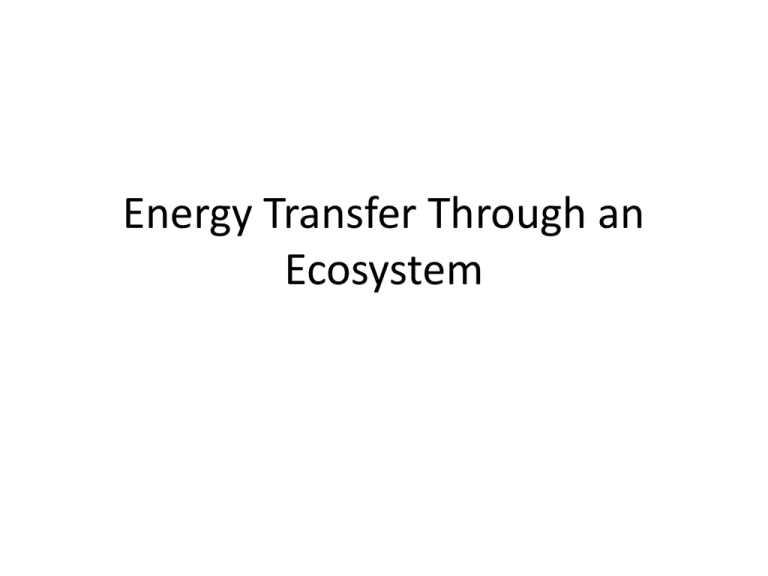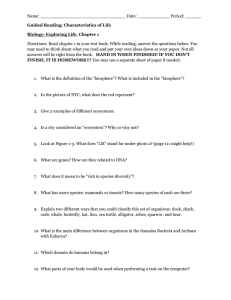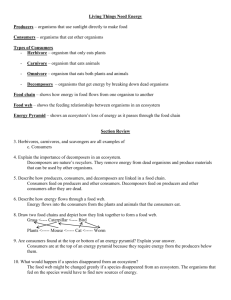Energy Transfer Through an Ecosystem
advertisement

Energy Transfer Through an Ecosystem Table of Contents Date Title Page 2/26/13 Energy Transfer in an Ecosystem 5 Goal: Students will determine how energy travels through ecosystems by identifying the relationships between producers, consumers, and decomposers. Recall: How is an ecosystem different from a community? What types of communities do you see in this picture? What type of ecosystem is it? Remember… • An ecosystem is the total of living parts (plants and animals) and nonliving parts (sunlight, air, water, soil) that support life in a unit of nature. We can refer to the Earth as one ecosystem or divide it into smaller units with similar characteristics. How is the energy role determined? • An organism’s energy role is determined by how it obtains food and how it interacts with other organisms. – Do you play an instrument? • Each instrument has a role in a piece of music. Similar to the instruments in a band, each organism has a role in the movement of energy through its ecosystem The living parts of an ecosystem can be divided into three categories: Producers: Organisms that can make their own food. Ex. Plants have chlorophyll and can produce their own energy in the form of carbohydrates (simple sugars) through photosynthesis. Consumers Animals must consume something else, either plants or other animals, to get their energy. There are different levels of consumers: top carnivores-eats other carnivores (ex. Wolf) carnivores -eats other animals (ex. Snakes) omnivores-eats plants and animals (ex. Humans) herbivores-eats only producers (plants) (ex. Rabbits) Decomposers Decomposers: break down biotic wastes and dead organisms and return the raw materials to the ecosystem. “Nature’s Recyclers” In any community, energy flows from producers to consumers. • Energy moves through the ecosystem in the form of food • When organisms die, decomposers obtain energy when they break down the bodies of dead organisms Food Chain • A food chain is a simple way of showing how energy (food) passes from one organism to another • Arrows between organisms indicate the direction that the energy is moving Food Chains (con’t) • Usually have 3 or 4 links • At each transfer of energy, a portion of the energy is lost as heat due to the activities or organisms as they search for food and mates Food Webs • A food web is a series of overlapping food chains • Organisms play more than one role in an ecosystem. • Remember the rule about the arrows! A Food Web Example video Create a Food Web • • • • • • Label: Producers Primary Consumers Secondary Consumers Tertiary Consumers Decomposers • Include arrows moving in the appropriate direction following the direction that the energy is being used • Primary (first-level) consumers eat producers • Secondary (second level) consumers eat primary consumers • Tertiary (third level) consumers eat secondary consumers • THE FIRST ORGANISM IN THE FOOD CHAIN/WEB IS ALWAYS A PRODUCER After you create your food web… • Using your food web, answer the following questions: • (a) Which organisms are producers? • (b) Which organisms are first order consumers? • (c) Which organisms are second order consumers? • (d) Which organisms are third order consumers?









